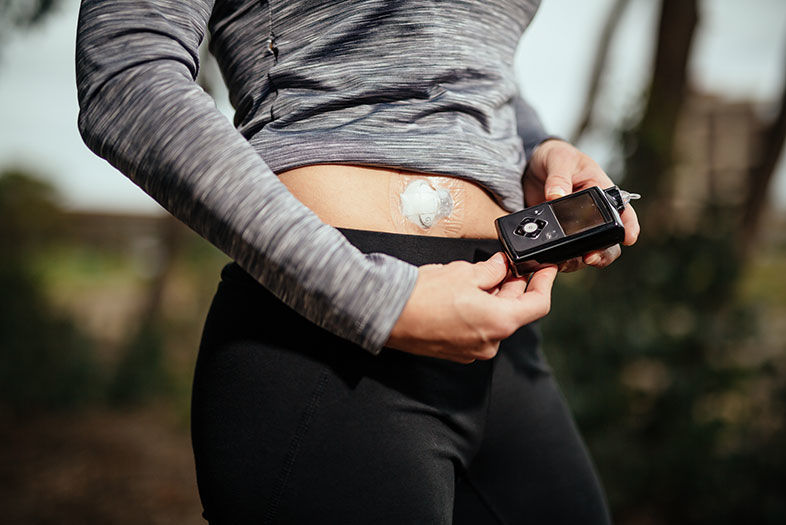Running 26.2 miles is a challenge for anyone. But running that kind of distance with Type 1 diabetes is a whole different race. Never mind just staying hydrated and worrying about putting one foot in front of the other; managing blood sugar levels for four hours of running or more means stopping every 30 minutes to perform a finger prick. Wait any longer than that and blood sugar levels could dip to a dangerously low point, risking insulin shock.
Kristy Castillo, 37, was diagnosed with Type 1 diabetes at 14 years old. Of the 29 million people living with diabetes in the US, around 5 to 10 percent have Type 1, formerly called juvenile diabetes (as opposed to Type 2, most often caused by excessive weight and lack of exercise, previously called adult-onset). The Carmel Valley resident began running in 2014 and, over the next three years, completed 15 half marathons. “Running is a release; it’s therapy for me,” she says.
In 2017, she decided she wanted to run something longer—the annual Rock ’n’ Roll Marathon in downtown San Diego. She gave herself six months to train for the June race. “I was struggling because I was wearing a pump and continuous glucose monitor during all my training,” she says. “But I was having a hard time keeping my blood sugars under steady control.”
So many factors influence your sugars when you’re running long distance, she explains, like what you eat, how hard you’re exercising, and how much stress you’re feeling—you even need to take your levels into account the day prior.
Fortunately, Castillo had an “in.” As a nurse at the Scripps Whittier Diabetes Institute, she was able to make a special request. She wanted to try Medtronic’s MiniMed 670G insulin pump—it’s the first FDA-approved hybrid closed loop device, which means it can automatically monitor sugar levels every five minutes through a sensor attached to the body, and, based on the reading, deliver the right amount of insulin through a hair-size needle.
“When you and I eat,” explains Dr. Athena Philis-Tsimikas, corporate vice president at Scripps Whittier, “we don’t think about how much insulin our pancreas is going to secrete in order to accommodate for the food we’re eating.”

How to Run a Marathon with Type 1 Diabetes
flavio scorsato
The MiniMed is known as an “artificial pancreas.” It was released just weeks before the race, and Castillo would be the first person in San Diego to run a marathon with it.
During the race, Castillo was thrilled she never had to think about anything besides running. The one exception was at the start, when runners experience an adrenaline rush. “When you’re pumped up and ready and you have anxiety, your blood sugars spike.” She took a dose of inhalable insulin, but after that, the MiniMed kept her sugars flat.
Perhaps even more exciting, she finished with an impressive time. Her pace for a half marathon fluctuates between 8:35 and 9 minutes per mile. “I finished the full marathon at a 9:15 pace. It was the best feeling ever. It was that true runners’ high.”
Castillo had never been able to fully enjoy that high. She knew from training how her body could react. “After finishing a run, I would sometimes have to take ten units of insulin—for me, that’s like eating a very large meal at a buffet,” she says. “But when your blood sugars are perfect, it’s scary to take a large dose. You’re playing the odds a little bit. You’re taking large doses to prevent highs, but then what if you don’t go high? Now you’ve got to shove your mouth with tons of carbs and sugar to prevent a severe low. So instead of just enjoying the moment, it’s ‘Okay, now I need to make sure that I’m safe.’”
The MiniMed was a game changer. She later took it on a swim in San Diego Bay, and it kept her blood sugars balanced the whole time.
And the technology advances every year. Dexcom and Tandem Diabetes Care—both San Diego companies—have collaborated on a similar system that’s water-resistant, easy to use, and requires no calibration.
In the future, Dr. Philis-Tsimikas says, we might see cells that can be injected or transplanted under the skin or within the liver that could sense and deploy insulin. Or smart insulin, which can remain inactive until an extra molecule attached to it senses that blood glucose levels are rising. This and other similar innovations will free people with diabetes from the need to think constantly about monitoring. “When you don’t have to think as hard, then the diabetes isn’t right there in your face,” says Castillo. “It’s living on the side.”
For research participation opportunities at Scripps Whittier Diabetes Institute, call 858-964-3133.

How to Run a Marathon with Type 1 Diabetes
Photos by Flavio Scorsato















